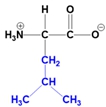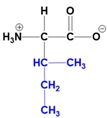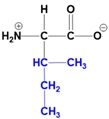So in our last lesson video, we said that the predominant structure of the amino acid backbone is a Zwitter ion specifically at physiological pH, which is a pH of 7. But the question is, what is the predominant structure when the pH is not at physiological pH? Like if the pH is 1 or 12, how do you then determine the predominant structure? Well, it turns out you already have the knowledge to be able to answer that question. In this video, I'm mostly just going to be refreshing your memory of older information that we already covered in our previous lesson videos. The first piece of information that I want you to recall from our previous videos is that the pKa is a quantitative measure of the strength of an acidic hydrogen. The greater the pKa value is, the weaker the acid will actually be.
The way we determine the predominant amino acid structure is by independently comparing each pKa value to the pH of the solution. When we independently compare each pKa value to the pH of the solution, we can determine the predominant amino acid structure at any given pH. Notice below, we have the same chart from our previous lesson videos that explains what we mean by comparing the pH of the solution to the pKa of the acid to determine the predominant species, and whether that species is protonated or not. We'll be able to refresh our memories on how to use this chart later on in this video.
In this video, there are only 2 new pieces of information that I want you to know. The first is that alpha amino groups, or amino groups that are part of the backbone of an amino acid, have pKa values in the ballpark range of about 9 to 10.5. The second new piece of information is that alpha carboxyl groups, or carboxyl groups that are part of the backbone of an amino acid, have pKa values that are in the ballpark range of about 2. Knowing these ballpark pKas is important because your professors expect you to know them, and they're going to be really helpful for us as we move forward and solve practice problems.
Notice that we have this graph up above here, and this graph is color-coordinated to the predominant structures that we see down below. You will see that this green predominant structure corresponds with the green line up above in our graph. The blue predominant structure corresponds with the blue line, and the pink predominant structure corresponds with the pink line. We will first fill out these predominant structures down below, and then we'll come back up and look at our graph and see how it relates.
In the center of our image here, we have the same exact image from our previous lesson video. We can see that the pH is right at 7, which is physiological pH, and the predominant structure of the backbone is a zwitterion where we have a protonated amino group on the left with a positive charge and a deprotonated carboxyl group (carboxylate) on the right with a negative charge. This positive charge cancels out with the negative charge and the backbone bone net charge, specifically at pH 7, is going to be 0.
Now if we take this pH of 7 and we drop it down to an acidic pH of 1, then we're going to need to use our previous knowledge to be able to determine the predominant structure, and we're going to have to independently compare each pKa to the pH of the solution. Notice that we're given a pKa for the amino group of 9, and a pKa of the carboxyl group of 2. So starting with the amino group, notice that the pH of 1 is less than the amino group pKa, which is 9. When the pH of the solution is less than the pKa, that means that the concentration of conjugate base is less than the concentration of conjugate acid, and the conjugate acid will be predominating. The majority of the molecules are going to be protonated and have an additional hydrogen. We can expect our amino group to be in the protonated form, which is the NH3+ form, and we'll have a positive charge.
If we do the same for the carboxyl group, notice that the pH of 1 is still going to be less than the carboxyl group pKa, which is 2. Again, when the pH is less than the pKa, the concentration of conjugate acid will be greater, and the majority of the molecules will be protonated. We can expect our carboxyl group to be protonated, and the protonated carboxyl group is just going to have an OH at this position, which is going to be neutral. Notice that we only have one charge here when our backbone is at a pH of 1. That means that the backbone net charge is just going to be plus one at a pH of 1.
Now, if we go ahead and increase the pH all the way up to a pH of 12, then we can perform the same strategy. Notice that when the pH of the solution is equal to 12, that is going to be greater than the amino group pKa, which is 9. When the pH of the solution is greater than the pKa, the concentration of conjugate base will be greater than the concentration of conjugate acid. That means that the majority of the molecules are going to be deprotonated and have one less hydrogen. We can expect our amino group to be in the deprotonated form, which is going to be the NH2 form, which has no charge on it.
We can do the same with our carboxyl group, and so when the pH of the solution is equal to 12, that's still going to be greater than the carboxyl group pKa, which is again 2. Again, when the pH is greater than the pKa, the concentration of conjugate base will be greater, and the majority of the molecules will be deprotonated. We expect our carboxyl group to be deprotonated. The deprotonated carboxyl group is going to be a carboxylate anion, which has a negative charge on it.
Notice that when the pH is 12, the predominant structure of our backbone only has one charge on it, so that means that the backbone net charge is going to be negative one at a pH of 12. Now, we can go ahead and relate these predominant structures to our graph up above, and you can see that when the pH is 7, right around physiological pH, that corresponds to our x-axis here, the pH of 7, right at this position. You can see that most of our molecules are going to be in the zwitterion form because the concentration is at its highest here. The zwitterion form has a neutral net charge of 0, like we indicated down below.
Now if we go ahead and drop the pH down to an acidic pH of 1, that will correspond right here, and you can see that the majority of our molecules, the highest concentration is going to be where both groups are protonated. You can see that when both groups are protonated in our backbone, the backbone has a plus one charge, and that corresponds to this pink line right here. Then, of course, if we take our pH and we increase the pH all the way up to a pH of 12, that's going to correspond right here on our x-axis, and you can see that the majority of our molecules are going to be in the deprotonated state in this blue that corresponds with this blue line here. Both groups will be deprotonated, and when both groups are deprotonated in the backbone, our backbone has a net charge of negative one.
This concludes our refresher on our lesson here, and we'll be able to utilize these two new pieces of information in problems moving forward. I'll see you guys in those videos.







